
I have gotten used to being size L, LL, 2L and XL in Japan. Gone are the days where I ever thought of myself as “average”. In the UK I was spoiled. I was the average size. I only needed an L size in snooty fashion shops where all the mannequins were seven feet tall and proportionally would weigh about 90 pounds.
But in Japan I am not M size. I am not average. I’m considered tall (166cm). I’m also considered rather severely overweight according to my health check (I weigh considerably more than the recommended 55kg for women). Strangely, this has affected my self-esteem very little, though it has made clothes shopping a rather unique experience. I now appreciate what plus-size women in the UK complained about – it can either be cute and too small, or hang like a sack and be the right size.
When it comes to kimono, which is a one-size garment made to fit the “ideal” Japanese female shape, I am grossly out of proportion.
For a start, most kimono and yukata hover around the 165cm length. You may notice that’s a centimeter shorter than my actual height. My kitsuke teacher has repeatedly told me that the kimono’s ideal length should be from my shoulders to the ground plus 30cm. I have only found one kimono that is long enough for this. Usually I buy a ‘TL’ size, a kimono that is 175cm, and call it quits.
But TL yukata and kimono have other issues. I can make 175cm work in length, but wrapping it around what I affectionately call my “booty”, requires a little more wriggle room. Then there’s my shoulders, which were large even for England. Oh, and my bust which is almost completely sized out of anything except the plus-size stores. So I need a kimono that is LL and TL.
But TL does not come in LL as well in most cases. You can either be taller, or bigger, but being both means you’re going to have to get creative with ohashiori or resign yourself to never having kimono meet your wrist bone.
Then there’s the parts that aren’t sticking out, but that are going in instead. I have a fuller shape than the one used for traditional kimono, which means I’m padding everything. Even if I compress my bust, I have to pad a great deal at the front to get the kimono to stand out. I remember being dressed for Tanabata last year and the poor women running out of towels to use to pad my in bits to my out bits. Similarly, I need double the amount of padding in the small of my back and at the waist compared to my less inny-outy Japanese friends.
The end result often makes me feel like I’m an overstuffed sausage, bloatedly waddling around with a good extra few kilos of towel and cushion attached to me. Of course, once the kimono is on, it doesn’t look like I have that much padding on, but I know it’s there.
I’m confident in how I look. I like myself. I like my style. I like my hair and my make-up and my booty and my cloven hooves that might have once been feet. Kimono has not changed that, but it has presented some interesting things for me to think about regarding my body. When buying I do have to start thinking that some things may be beyond me due to my size, I do have a narrower selection to choose from even when buying things new.
Am I bitter about it?
Sometimes I am a little. But for the most part, I have come to terms with the fact that I am not kimono shaped, Japanese shaped, or “average” anymore.
And that’s completely and utterly okay with me.


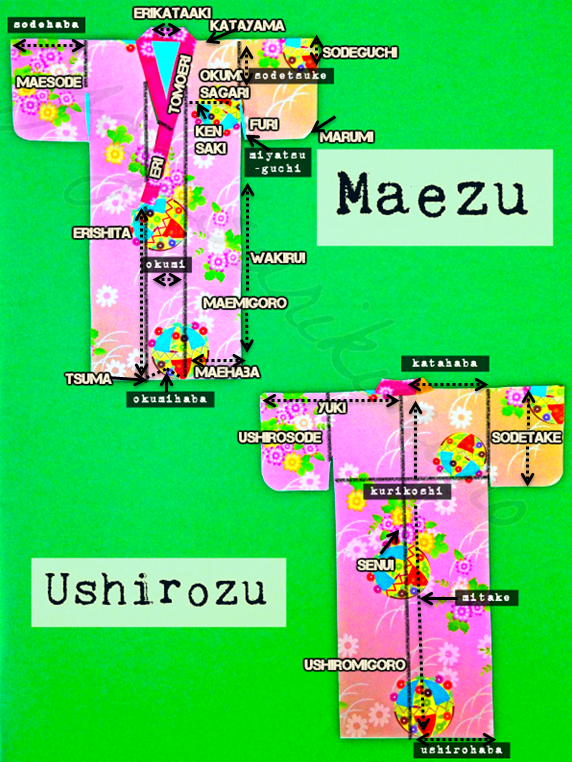

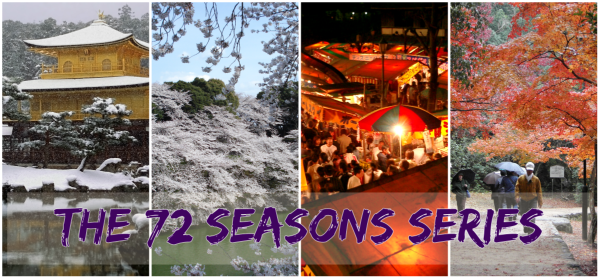

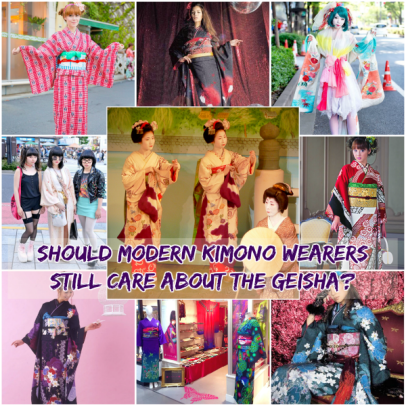
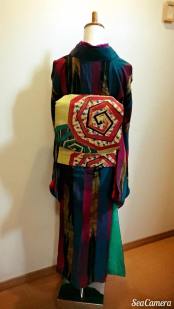 Before the inevitable furore erupts, I must make my point clear. I do believe the geisha have their place. As a resource, they are fantastic and keeping up with maiko kanzashi and their ensembles at the dances is still fun, informative and interesting. This blog piece isn’t going to be about that.
Before the inevitable furore erupts, I must make my point clear. I do believe the geisha have their place. As a resource, they are fantastic and keeping up with maiko kanzashi and their ensembles at the dances is still fun, informative and interesting. This blog piece isn’t going to be about that.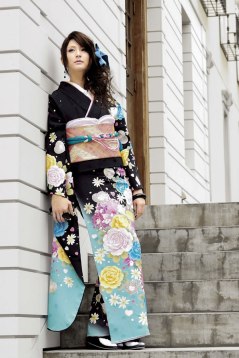 For the newbie starting out, kimono with all it’s new words and jargon is a difficult field to navigate. Drowning in information, and then suddenly being able to find no information specific to what you need, is almost certainly commonplace. Even those who have extensive kimono knowledge will sometimes come across a kimono that just makes them stare blankly at the fabric for a few moments, trying to place seasonality by lining or fabric or tiny motif.
For the newbie starting out, kimono with all it’s new words and jargon is a difficult field to navigate. Drowning in information, and then suddenly being able to find no information specific to what you need, is almost certainly commonplace. Even those who have extensive kimono knowledge will sometimes come across a kimono that just makes them stare blankly at the fabric for a few moments, trying to place seasonality by lining or fabric or tiny motif.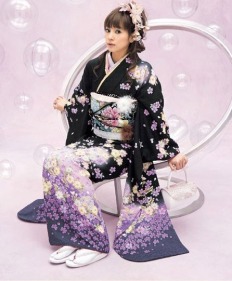 Yet it’s also daunting for a newbie – to see a geisha in all her finery held up as the example. I’m sure many of us remember our first time wearing kimono. How our collars would not do what they were told, how our obi came undone or was too loose, how our hem was lop-sided and our himo dug into our ribs so hard we couldn’t take a step without shooting pains? If we hold ourselves up to, what is essentially the Beyonce of the kimono world, we will always feel we are falling short.
Yet it’s also daunting for a newbie – to see a geisha in all her finery held up as the example. I’m sure many of us remember our first time wearing kimono. How our collars would not do what they were told, how our obi came undone or was too loose, how our hem was lop-sided and our himo dug into our ribs so hard we couldn’t take a step without shooting pains? If we hold ourselves up to, what is essentially the Beyonce of the kimono world, we will always feel we are falling short.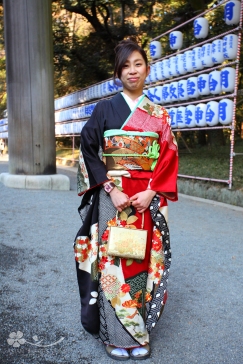 The whimsy, fun and sheer joy of some of these designs and ways of wearing harks back to what the geisha were back when they were innovating kimono. The move towards designs that echo the modern world, rather than harking back to the past, shows that kimono can withstand the test of time. Young people are having fun, experimenting and moving the fashion forward in unexpected and exciting ways.
The whimsy, fun and sheer joy of some of these designs and ways of wearing harks back to what the geisha were back when they were innovating kimono. The move towards designs that echo the modern world, rather than harking back to the past, shows that kimono can withstand the test of time. Young people are having fun, experimenting and moving the fashion forward in unexpected and exciting ways.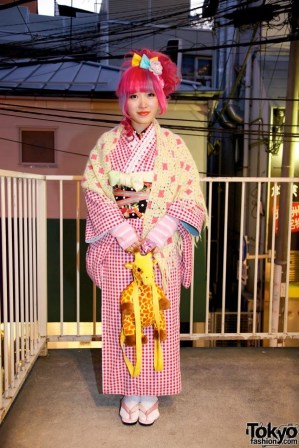 Traditional kimono are usually found on the second hand market for western buyers. Their price long-since paid, they have languished in drawers for decades until someone moves or dies, and they get put into secondhand stores and recycle shops. Many of us who buy these kimono aren’t supporting the traditional artisans who made them. Very few people do. The prices are extortionate, and only a select few can afford to have any kimono made from scratch these days.
Traditional kimono are usually found on the second hand market for western buyers. Their price long-since paid, they have languished in drawers for decades until someone moves or dies, and they get put into secondhand stores and recycle shops. Many of us who buy these kimono aren’t supporting the traditional artisans who made them. Very few people do. The prices are extortionate, and only a select few can afford to have any kimono made from scratch these days.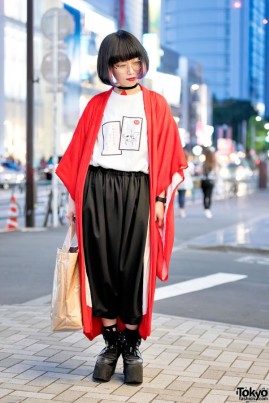 And so it comes to the main point:
And so it comes to the main point: